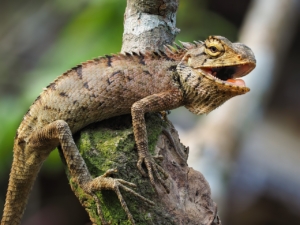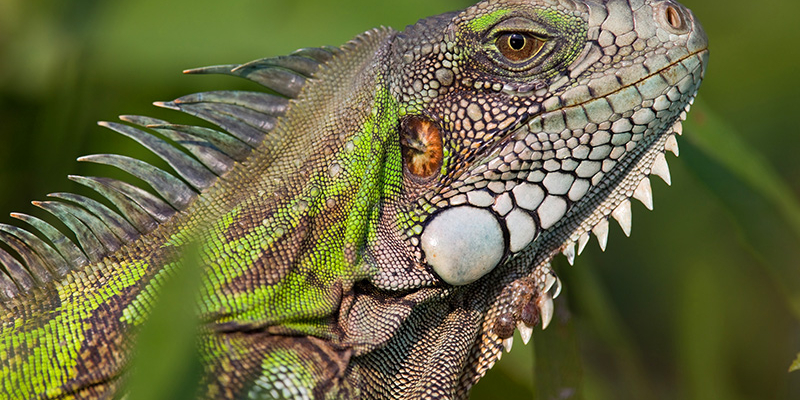Have you ever wondered what makes iguanas so special? These captivating reptiles, often seen basking in the sun or gracefully navigating treetops, are full of surprises. From their dazzling colors and unique physical features to their extraordinary survival skills, iguanas offer a treasure of fascinating facts waiting to be discovered.
Whether you’re a reptile enthusiast or just curious about the animal, prepare to be intrigued as we dive into the fun and surprising world of iguanas. Get ready to uncover some truly amazing facts about these remarkable lizards!
Table of Contents:
- Colorful Chameleons
- Vegetarian Diet
- Third Eye
- Their Size
- Strong Swimmers
- Defensive Mechanisms
- Ability to Communicate
- Tree Dwellers
- Regrowing Tails
- Solar Power
10 Interesting Facts About Iguanas
1. Colorful Chameleons
Iguanas can change their skin color as a response to their environment, stress levels, and social signals. This color change is achieved through the expansion and contraction of specialized cells called chromatophores, which contain different pigments. For example, an iguana might turn darker when basking in the sun to absorb more heat or become brighter during social interactions to assert dominance.
2. Vegetarian Diet
Iguanas are primarily herbivores, feeding on a diet rich in leaves, flowers, and fruits. Their diet is crucial for their digestive health, as their large intestines have evolved to break down tough plant fibers through fermentation. This plant-based diet provides them with all the necessary nutrients, and in captivity, they thrive on a mix of leafy greens, vegetables, and occasional fruits.
3. Third Eye
The parietal eye, located on the top of an iguana’s head, is a primitive photoreceptive organ. Although it doesn’t form images like their two primary eyes, it can detect changes in light and shadow, helping iguanas sense potential predators from above. This “third eye” plays a crucial role in their survival, allowing them to react quickly to threats even when they are not directly visible.
4. Impressive Size
Green iguanas (Iguana iguana), one of the most recognized species, can grow up to 6 feet in length, with their tail making up a significant portion of their total size. These lizards can weigh up to 20 pounds. Their impressive size not only makes them a formidable presence in their habitat but also an attractive pet for reptile enthusiasts, despite the challenges of providing adequate space and care.
5. Strong Swimmers
Iguanas are proficient swimmers, a skill that aids in their survival in their natural habitats, which often include rivers, lakes, and coastal areas. They use their powerful tails to propel themselves through the water and can hold their breath for up to 30 minutes. This ability allows them to escape predators and explore their environment more thoroughly.
6. Tail Whip Defense

Iguanas use their long, muscular tails as a weapon to fend off predators. When threatened, they can deliver a swift and powerful whip with their tail, which can cause significant pain and injury to the attacker. This defense mechanism is particularly effective against smaller predators and is often accompanied by hissing and head bobbing to further intimidate the threat.
7. Communication Skills
Iguanas use a combination of head bobs, body posture, and dewlap extensions to communicate with each other. Head bobs can vary in speed and intensity, conveying different messages such as aggression, submission, or courtship. The dewlap, a flap of skin under the chin, is often extended to appear larger and more dominant or as a signal during mating displays.
8. Tree Dwellers
As arboreal animals, iguanas spend most of their time in trees, where they find food, bask in the sun, and stay safe from ground-based predators. Their sharp claws and strong limbs allow them to navigate branches with ease. In tropical rainforests, they can often be seen basking on tree limbs, soaking up the sunlight needed for thermoregulation.
9. Regrowing Tails
If an iguana loses its tail to escape a predator, it can regenerate a new one, although the new tail might not be as long or as perfectly formed as the original. This regenerative ability is a critical survival adaptation. The process involves the growth of new cartilage, muscles, and skin, allowing the iguana to maintain its balance and defense mechanisms even after an attack.
10. Solar Power
As ectothermic (cold-blooded) animals, iguanas rely on external heat sources to regulate their body temperature. They spend a significant amount of time basking in the sun, which helps them maintain their metabolic functions and energy levels. In cooler environments, they become sluggish and less active. Sunbathing also aids in the synthesis of Vitamin D, which is essential for calcium absorption and bone health.
Frequently Asked Questions
How long do iguanas live?
Iguanas typically live between 10 to 20 years in the wild, depending on factors like predation and habitat quality. In captivity, with proper care, including a balanced diet and suitable living conditions, they can often live longer, sometimes exceeding 20 years.
What sound does an iguana make?
Iguanas are generally quiet reptiles, but they can make a few sounds, particularly when they feel threatened or are communicating. They may hiss, which is a common defensive sound indicating they feel threatened or agitated. Additionally, they can produce clicks or chirps, usually during social interactions or mating displays. However, iguanas primarily rely on body language and visual signals rather than vocalizations for communication.
Iguana Facts for Florida Residents & Guided Iguana Hunts
Iguanas are fascinating creatures that can make excellent pets if provided with proper care and suitable conditions. There are many intriguing facts about iguanas for those interested in keeping them.
However, in Florida, green iguanas pose a threat to native species and ecosystems. Join the fight to protect Florida’s native wildlife! Book a guided iguana hunting trip with us today and help control the invasive green iguana population. Contact us now to schedule your adventure.


